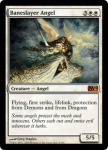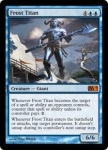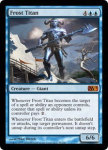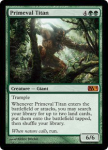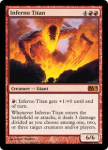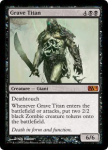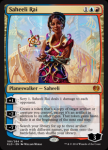Oversoul
The Tentacled One
I've been playing Magic for almost 24 years. In that time, I've seen some of my friends quit the game and I've seen a few of them come back. Some people quit the game and return to the game multiple times. In all that time, I've never formally quit the game myself, nor have I gotten rid of my cards. But there have been periods of relative inactivity. In some of these, I'd actually kind of say that the CPA itself was my lifeline to the game, as even if I wasn't taking time to keep up with things in any other capacity, I was still dropping by these message boards and reading your posts. So yeah, thanks everybody! 
Sometimes I think that WotC overdoes things with reprinting a particular card multiple times in relatively short succession. But in the case of Sun Titan, I'm grateful that they persisted.
- The first significant lull in my Magic-playing was in late 2001. My family had moved out into the boondocks relatively recently. I was in my sophomore year in high school and was attending a different school from the ones the friends in my main Magic playgroup were attending. I'd opened two or three packs of the latest set, Odyssey, but didn't really know the set or care about it. At my old house, I'd been able to walk to my local game store. At the new house, I was kind of far away from everything. I kept a few decks together, but didn't have anyone to play with. I think that when Torment came out, I didn't even know about it. So I was out of the loop. At some point in 2002, my high school was subject to a bomb threat and all of the students were evacuated. I found a cluster of students playing Magic outside and chatted with them, which got me back into the game. We had a playgroup going for the rest of high school. It was while browsing the web for ideas to bring to our after school game club that I found the CPA, some time in 2003.
- That first lull was the most detached from the game I've ever been, and I've never come as close to quitting as I did way back then. But the whole interval in question was a matter of months. I had a more extended lull from 2005 through 2007, when most of my friends in my casual playgroups either quit the game or moved away. Toward the end of that, the CPA was pretty much the only place I went for anything Magic-related. In 2008, I changed jobs and started to focus more on Magic.
- Even though I can certainly find some activity here at the CPA, that second lull was somewhat more pronounced for my real, face-to-face gameplay and probably represented the most time, overall, that I wasn't really involved with the game. I delved back into Magic in 2007, but after a few more years, I hit a weird snag. The full context would take a while to go through, so I'll summarize. Starting in 2008, I was part of a three-person informal "team" that focused on the Legacy format and spent time together testing decks for Legacy tournaments, although I think we only actually attended two actual tournaments together. As part of this focused playtesting, all of my Magic cards were consolidated with the collection of my longtime friend, former CPA member Al0ysiusHWWW. We did our playtesting at his house and it was a better place to store the cards. When our "team" fell apart in 2010 (for logistical and time commitment reasons that is; we're all still friends), I no longer had my cards with me anymore. In a sense, this was a more extreme departure from the game than the first two: I physically didn't have my cards with me anymore. Also, during this time I went back to school at my local community college and took some classes in preparation for trying to get into a university. And I went on a couple of major trips, including that time I went to Europe. I maintained some presence here at the CPA and continued to follow the Legacy format on my own, but other than that, I wasn't playing Magic at all. This lull was broken when Al0ysiusHWWW and I moved into an apartment together in December of 2010.
- With Al0ysiusHWWW as a playtest partner, I remained somewhat active in the Legacy format throughout 2011. After that, I started to immerse myself in my schoolwork and mostly lost track of everything going on in Magic. I wasn't even here at the CPA very much. This final lull was broken after I graduated with my university degree.
Sometimes I think that WotC overdoes things with reprinting a particular card multiple times in relatively short succession. But in the case of Sun Titan, I'm grateful that they persisted.

